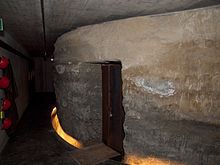Meyersche Stollen
The Meyer's tunnels are a system of underground structures under the Swiss city of Aarau , the known parts of which are 1.7 km long. The tunnels were built by the silk ribbon manufacturer, revolutionary, alpinist and forger Johann Rudolf Meyer Sohn (1768–1825) between 1791 and around 1810 and were used on the one hand to drain marshy terrain and on the other hand to obtain water for a dye works and water power for a factory.
Emergence
The tunnels were built in three stages: the first began in 1791 and was used to drain parts of the land that belonged to the siblings of Meyer's wife Margarete Saxer. After Meyer had acquired the aforementioned land, he built a villa there in 1794–1797, the Meyerhaus . The second construction phase began. Its aim was to obtain water for the silk dyeing that Meyer set up in the two basement floors of the building. In 1807 he returned from Bavaria, where the Meyer family had transferred their factory and assets after the Stecklikkrieg ; around 1810 he built a new factory behind the villa. The third construction phase falls in these years. At that time Meyer provided the tunnels with a dam so that the inflowing water in the underground of the factory could drive a water wheel with a diameter of 9.5 m. This put finishing machines ( calender , mangle , smoothing machine) and a bellows into operation.
The miners needed to build the tunnels probably came from the Küttigen iron mine , which until 1798 from the Republic of Bern , 1799/1800 from Meyer and his friend Johann Samuel Gruner (1766–1824), then from the Helvetic Republic and 1803–1820 from the canton Aargau was operated. 1795–1803 it was under Gruner, who had studied mining science in Freiberg (Saxony) . He was also likely to have been involved in the planning of the tunnels. Meyer himself, to whom geological investigations have always been a favorite subject, published a geognostic overview of the Helvetian mountain formations in 1805, which is accompanied by an early geological map of the country.
The construction of the tunnels was carefully carried out and corresponds to the state of the art at the time. Small underground weirs, reservoirs and a system of cross tunnels allowed the inflowing water to be dammed up during non-working hours and then used in a targeted manner.
Another fate, state of preservation
After the death of Meyer's son Johann Gottlieb (1793–1829), the factory and villa became the property of the Feer family. After 1860, this replaced the water wheel with a turbine. In the 1880s, the use of the tunnels was discontinued.
Below the Meyerhaus , which was converted into a Roman Catholic parsonage in 1939, the rooms of the dye works and the drainage tunnel towards the Aare have been preserved, and parts of the water-bearing inlet tunnel in the area of the station . There is now a gap in between, because when the main post office was expanded in the 1980s, the Radstube was destroyed along with the factory. Unknown sections of the tunnel are still being discovered during civil engineering work.
Tunnel tours, exploration of the Meyerstollen
The underground structures under the Meyerhaus can be viewed on guided tours. Information is provided by the Meyersche Stollen IG (community of interests) founded in 1999.
On the third basement floor of the new train station, the Meyerstollen outcrop was opened in 2010 and is affiliated with the Aarau City Museum. Visitors can safely visit a few meters short section of the tunnels over a footbridge. In addition, a small exhibition provides information about various aspects of this architectural monument from the early industrial age and illuminates the fate and worldview of the builders. This includes a corresponding school offer with which this knowledge is imparted. In addition, the opening of the Meyerstollen enables cultural events to be held. He also reminds that the existing tunnels must be explored and secured for the long term.
literature
- Peter Genner: Johann Rudolf Meyer son (1768–1825) and the Meyer family. Website IG Meyersche Stollen, Aarau 2015 ( digitized version ).
- Andreas Zimmerli: The Meyer's tunnels in Aarau. A building history of this extraordinary facility. Website IG Meyersche Stollen, Aarau 2015 ( digitized version ).
Web links
Individual evidence
- ↑ Review in: Heinrich Zschokke (editor), Miscellen for the latest world studies, May 18 and 25, 1808, critical supplements, here: May 18.
- ↑ In: Heinrich Zschokke (editor), Isis, October 1805, pp. 857–878, 1121 (“by Rudolf Meyer in Aarau”).
Coordinates: 47 ° 23 '37.6 " N , 8 ° 3' 1.3" E ; CH1903: 646 185 / 249398


